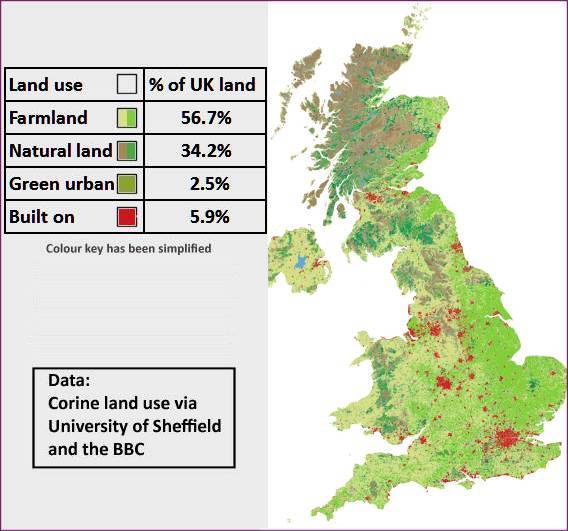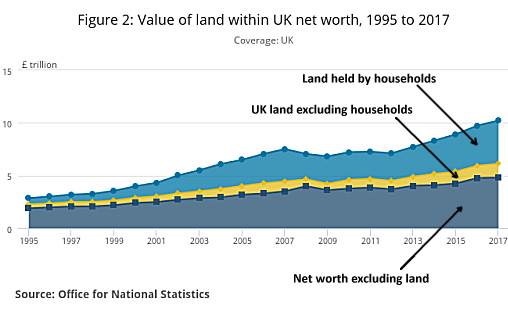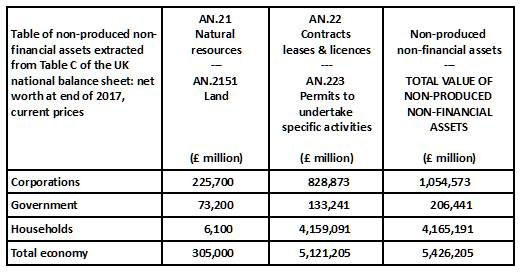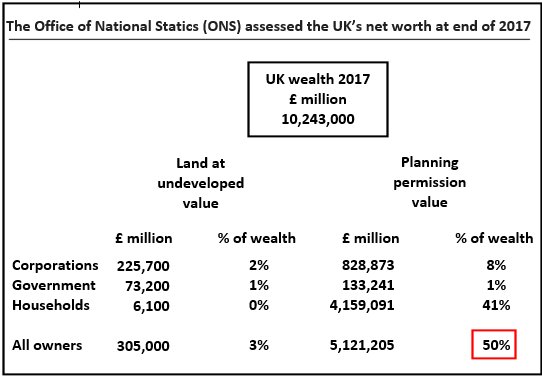Planning permission is not a natural resource
Note 4th January 2023: Recently, I have been using a clearer term, “Property Location Rights”, to stand for the legal rights that planning permission creates.
“Property Location Rights are not natural resources” would have been a clearer title.
Planning permission is not a natural resource
Planning permission is not natural: It is artificial, “made or produced by human beings rather than occurring naturally.” However, the Office of National Statistics treats it as a natural resource.
However, the ONS does now divide the value of a house into the value of the “bricks & mortar” and the land it stands on. Their next step should be to separate the land value into the value of the land, if it had no planning permission and the increase in value that planning permission creates.
This note attempts to do just that.
Not much of the UK land is built on:

Example: Planning gain in York
An earlier article Planning gain in the York Local Plan calculated that in York a typical plot of agricultural land worth £600 has its value increased to £182,000 when planning permission to build a house on it is given: an increase in value of over 300 times.
Here it is argued that this increase is not correctly accounted for by saying ‘the land’ has increased in value but by saying the increase in value divided between the land and another entity, a planning permit. This is the right to have a building on the plot. This division is semantic but, as will be seen in future articles, it is important.
In economics, land is a natural resource with fixed supply. Planning permits are not. I suggest that the two should be considered separately. This means the ‘plot value’ is divided into the values of land and the value of ‘planning permits’.
Planning permits are ‘the rights that planning permission creates’ but not all have been created by planning processes. Planning permits, as meant here, include historic rights that were acquired because they have existed for sufficient time. (Cf. Certificate of lawfulness.)
Here, the value of land (‘land as a natural resource’) will be assumed to be the best guess at its ‘default use’: agriculture or natural land. In the context of this article, this is not an important choice.
The ONS calculate land to be over half the UK’s wealth:

In The UK national balance sheet 2018, The Office of National Statics (ONS) assessed the UK’s net worth at end of 2017 as £10,243 billion. (Table C). Table 1 is an extract from Table C relevant to land:

The largest part of national wealth is the £5,423 billion value of land. As the ONS assessed the total net worth of UK assets as £10,243 billion, land is 53% of national wealth.
What type of land is most valuable?
The UK has a land area of 243,610 sq km (CIA World Factbook). Percentages for different uses are documented by The University of Sheffield and summarised by the BBC:

Although built up land covers a much smaller area than farm land or natural land the ONS valuation makes it very much the most valuable.
The value of buildings and other structures
Land that is ‘built on’ contains dwellings and other buildings such as shops, offices and factories. It also contains other structures such as roads, railways and bridges. The ONS has calculated their value:

Buildings account for 26.47% of national wealth. (With other structures that increases to
35.34%. )
The value of the ‘natural resource land’
In Table 1 , land is classified as ‘natural resources’. It is categorised in contrast to ‘permits to undertake specific activities’ under ‘non-produced, non-financial asset’. A System of National Accounts 2008 (United Nations) gives examples of permits, such as a taxi licence, giving the right to operate as a taxi, or a casino licence giving the right to operate a casino.
If a building were demolished, without the right of re-building, the value of the plot it stood on would be tiny. What makes the plot valuable is the right to have a building on that land. This right is a permit, a planning permit, similar to the operating licence to run a casino.
[Note on planning permits: The key point of this article is that the value of a plot of land can be divided into two separate components: its ‘value as a natural resource’ and the value of the right to use the plot in a particular way.
There are many different rights that might govern the use of a plot, either granted by law or historically assumed.
For the purposes of this article, the term planning permit will refer to the right to have a building or ‘other structure’ on the plot. In most cases, the value of the planning permit greatly exceeds a plot’s ‘value as a natural resource’.]
Granting planning permission for a plot of land is issuing a planning permit to undertake a specific activity such as building a house. This is in the same category as issuing a licence for a casino. Granting planning permission is not creating extra natural resource, it is simply issuing a planning permit.
Table 4 estimates the value of ‘land as a natural resource’, excluding the value of planning permits. This only affects ‘built on’ land. An assumption has been made that its value per hectare is the same as farmland.

This means reducing the values in column AN.2151, ‘Land’ in Table 1 to the value of ‘land as a natural resource’ , estimated in Table 4, and reassigning the excess value to column AN.233, Permits to undertake specific activities.
Planning permits are not ‘natural resources’
Planning permits should not be counted under AN.21, Natural resources
In order to update Table 1, assignments to ownership category are needed. Table 5 has been used for this but several large assumptions have been made about the proportions of land owned by corporate, government and households. Table 5 should be regarded as illustrative.

For new buildings, granting planning permission creates new planning permits. However, the right to have a building on a site may have been acquired many decades or centuries ago – even before planning permission existed. In these cases, if rights exists, and buildings are permitted to remain and an implied planning permit exists.
Clearly issuing a planning permit does not create any natural resource. Table 1a is the corrected version of Table1.

The value in the third column of Table 1a Table 1a is £5,121 billion, 50% of national wealth. The overwhelming proportion of this (99.94%) is the value of planning permits. Those permits that are created by planning permission.
A planning permit is not a natural resource. It is a right controlled by government legislation. ONS accounting should be changed.
Planning permission value is 50% of UK national wealth
Planning permits make up the planning permission value of the UK. They are 50% of UK national wealth.

Government controls this source of “wealth”
The value of planning permission is determined by the balance between supply and demand. Government controls the planning system, which in turn controls the rate at which planning permits are created. Consequently, through the planning system, the Government is in control of the value of planning permission, which has created half of the wealth of the country.
